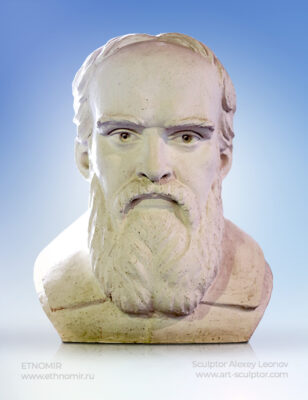GALILEO GALILEI. 2011.
Author: Alexey Leonov
Material: Chamotte
Location: "ETNOMIR" Cultural Education Center
“The aim of the scientist is to study the great book of nature, which is the real subject of philosophy”.
GALILEO GALILEI
Italian physicist, mechanic, astronomer, philosopher, poet, philologist, critic and mathematician, one of the founders of the exact science of modern times. Years of life 1564-1642
The founder of experimental physics, Galileo laid the foundation for classical mechanics, in particular dynamics, discovered the law of inertia, the laws of free fall, the body’s motion on an inclined plane, the law of the addition of motions and the law of constancy of the oscillation period of a pendulum. He also investigated the strength of materials. Many studies by Galileo were devoted to physical optics, the nature of color. Galileo designed a hydrostatic balance to determine the proportion of solids, invented a thermometer. The basis of Galileo’s worldview is the recognition of the objective existence of the world outside and independently of human consciousness. Galileo Galilei was the first to use a 32x zoom telescope to observe celestial bodies. He made a number of outstanding astronomical discoveries: he discovered the phases of Venus, sunspots, four satellites of Jupiter and the mountains on the Moon.
WORKS 8 volumes: “On Motion” (1590), “Mechanics” (1593), “The Starry Messenger” (1610), “Discourse on Floating Bodies” (1612), “History and Demonstration Concerning Sunspots” (1613), “The Assayer” (1623), “Dialogue Concerning the Two Chief World Systems” (1632), “Discourses and Mathematical Demonstrations Relating to Two New Sciences” (1638).
____________

